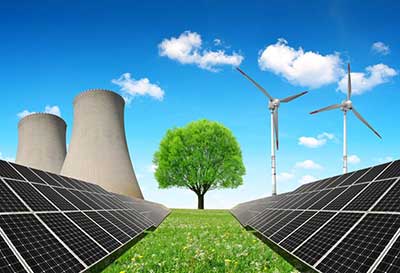Relevance: GS-3: Conservation, environmental pollution and degradation.
Key phrases: Climate emergency, Energy security, Renewable energy, Bioenergy, Thermal sources, Hydropower, Geothermal power, Wind energy, Solar power, Harmful gases, Acid rain, Global warming, Energy Technology
Why in News?
- As the fallout of Russia’s invasion of Ukraine ripples across the globe, the response of some nations to the growing energy crisis has been to double down on fossil fuels, pouring billions more dollars into the coal, oil and gas that are deepening the climate emergency. It is the only way to limit climate disruption and boost energy security.
Renewable energy in world:
- Renewable energy use increased 3% in 2020, as demand for all other fuels declined.
- Share of renewables in global electricity generation jumped to 29% in 2020, up from 27% in 2019.
- Solar PV and wind are set to contribute two-thirds of renewables growth.
- China alone accounted for almost half of the global increase in renewable electricity in 2021, followed by the United States, the European Union and India.
- Long-term contracts, priority access to the grid, and continuous installation of new plants underpinned renewables growth despite lower electricity demand, supply chain challenges, and construction delays in many parts of the world.
Renewable energy in India:
- Indian renewable energy sector is the fourth most attractive renewable energy market in the world.
- India was ranked fourth in wind power, fifth in solar power and fourth in renewable power installed capacity, as of 2020.
- At present, thermal sources of energy make the largest – 61.42 per cent — share of total installed capacity in utilities followed by RE resources at 24.7 per cent and hydro by 12.09 per cent.
- Renewable energy (excluding large hydro) constitutes around 10.7 per cent of the electrical energy generation for 2020-21.
- As of October 2021, India’s total RE installed capacity (excluding hydro power above 25 MW) has reached over 103.05 GW.
- The difference in the share of renewable energy in installed capacity and electricity generation is because of the variability in the sunshine hours or extent of wind which in turn will determine the utilisation of the installed capacity.
- Renewable resources include biomass energy (such as ethanol), hydropower, geothermal power, wind energy, and solar energy.
- India has an estimated renewable energy potential of about 1100 GW from sources like Wind – 302 GW, Bio-energy – 25 GW, Small Hydro – 21 GW and Solar power – 750 GW.

Effect of Fossil Fuel Energy:
- Harmful gases:
- Burning of fossil fuels emits hazardous chemicals such as sulphur dioxide and nitrogen oxides and other harmful gases are released in the atmosphere.
- Climate crisis:
- Fossil fuels are the cause of the climate crisis. Renewable energy can limit climate disruption and boost energy security.
- Acid rain:
- Quick dissolution of the SO2 and NO2 in water resulted in acid rain.
- Global warming:
- Fossil fuel intensifies global warming and climate change which ultimately leads to extreme weather events.
- Global mean temperature in 2021 was around 1.11 ± 0.13 °C above the 1850–1900 pre-industrial average.
- The most recent seven years, 2015 to 2021, were the seven warmest years on record.
- Fossil fuel extraction devastates huge stretches of land for establishment of infrastructure such as roads, pipelines, processing facilities, and waste storage in addition to the main extraction site.
India international effort to boost renewable energy:
- International Solar Alliance (ISA):
- The ISA was conceived as a joint effort by India and France to mobilise efforts against climate change through the deployment of solar energy solutions.
- It was presented by the leaders of the two countries at the 21st Conference of Parties (COP21) to the UNFCCC held in Paris in 2015.
- ISA is a coalition of solar resource rich countries lying fully or partially between the Tropic of Cancer and the Tropic of Capricorn
- The ISA is an intergovernmental treaty-based organisation with a global mandate to catalyse solar growth by helping to reduce the cost of financing and technology.
- One Sun One World One Grid:
- At the COP-26 climate summit in Glasgow, India launched ‘One Sun One World One Grid’ (OSOWOG).
- The One Sun One World One Grid (OSOWOG) is a transnational electricity grid supplying power all over the world.
- The idea was first proposed by Prime Minister Narendra Modi’s during the first assembly of the International Solar Alliance (ISA) in 2018.
- Its aim is to provide energy to about 140 countries through a common grid that will transfer solar power.
Measures to boost renewable energy:
Antonio Guterres Secretary-General of the United Nations proposed Five-point plan to boost renewable energy around the world.
- Access to Energy Technology:
- Make renewable energy technology a global public good, including removing intellectual property barriers to technology transfer.
- Address Supply-Chain Constraints:
- Improve global access to supply chains for renewable energy technologies, components and raw materials.
- Need a global coalition to boost renewable energy around the world
- Shipping bottlenecks and supply-chain constraints, as well as higher costs for lithium and other battery metals, are hurting the deployment of such technologies and materials.
- Red Tapisim:
- Cut the red tape that holds up solar and wind projects. We need fast-track approvals and more efforts to modernise electricity grids.
- Energy Subsidies:
- World must shift energy subsidies from fossil fuels to protect vulnerable people from energy shocks and invest in a just transition to a sustainable future.
- Investments:
- Need to triple investments in renewables. This includes multilateral development banks and development finance institutions, as well as commercial banks.
Government Initiative to boost renewable energy:
- Green Energy Corridor (GEC) projects: This is aimed at synchronising electricity produced from renewable sources, such as solar and wind, with conventional power stations in the grid.
- Pradhan Mantri Kisan Urja Suraksha evam Utthaan Mahabhiyan (PM-KUSUM) scheme to promote RE in the farm sector, over 77,000 stand-alone solar pumps, 25.25 megawatt (MW) capacity solar power plants and over 1,026 pumps were solarised as of December, 2021.
- National Clean Energy Fund: It is the fund created using the carbon tax for backing research and development of innovative eco-friendly technologies.
- National Wind-Solar Hybrid Policy, 2018: Through this policy, the government seeks to promote new renewable energy projects and hybridisation of the existing ones.
- Off-Grid and Decentralised Solar Photo Voltaic Applications Programme: This scheme aims to promote off-grid application of the Solar Photovoltaic (SPV) systems for meeting the lighting and electricity needs of the individuals
- Sustainable Rooftop Implementation for Solar Transfiguration of India (SRISTI) scheme: This scheme provides financial aids to the beneficiaries who install a solar power plant at the rooftop within the country ts.
Way forward:
- The renewable energy sector can continue to grow significantly and play a key role in India's and the world's ambition in tackling climate change.
- However, several interventions are needed to continue this impressive growth: Distribution Company reforms, a framework to adopt new developments like battery storage solutions and off-shore wind turbines, and technology solutions to integrate an increasing share of renewables into the grid.
- There is a need to address the demand-side flexibility, power plant flexibility, storage (pumped-storage hydro and batteries) and grid flexibility, as well as policy, market and regulatory solutions for the short to long term.
Source: Indian Express
Mains Question:
Q. “Renewable Energy can be a way to limit climate disruption and boost energy security”. Discuss.



















